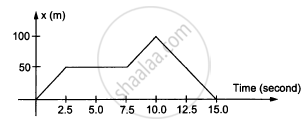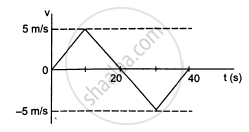Advertisements
Advertisements
Question
A person standing near the edge of the top of a building throws two balls A and B. the ball A is thrown vertically upward and B is thrown vertically downward with the same speed. The ball A hits the ground with a speed vA and the ball B this the ground with a speed vB. We have
Options
vA > vB
vA < vB
vA = vB
the relation between vA and vB depends on height of the building above the ground.
Solution
vA = vB
Total energy of any particle = \[\frac{1}{2}m v^2 + mgh\]
Both the particles were at the same height and thrown with equal initial velocities, so their initial total energies are equal. By the law of conservation of energy, their final energies are equal.
At the ground, they are at the same height. So, their P.E. are also equal; this implies that their K.E. should also be equal. In other words, their final velocities are equal.
APPEARS IN
RELATED QUESTIONS
When a particle moves with constant velocity, its average velocity, its instantaneous velocity and its speed are all equal. Comment on this statement.
A ball is thrown vertically upward with a speed of 20 m/s. Draw a graph showing the velocity of the ball as a function of time as it goes up and then comes back.
The range of a projectile fired at an angle of 15° is 50 m. If it is fired with the same speed at an angle of 45°, its range will be
The velocity of a particle is zero at t = 0.
(a) The acceleration at t = 0 must be zero.
(b) The acceleration at t = 0 may be zero.
(c) If the acceleration is zero from t = 0 to t = 10 s, the speed is also zero in this interval.
(d) If the speed is zero from t = 0 to t = 10 s the acceleration is also zero in this interval.
Mark the correct statements:
It is 260 km from Patna to Ranchi by air and 320 km by road. An aeroplane takes 30 minutes to go from Patna to Ranchi whereas a delux bus takes 8 hours. Find the average speed of the plane.
It is 260 km from Patna to Ranchi by air and 320 km by road. An aeroplane takes 30 minutes to go from Patna to Ranchi whereas a delux bus takes 8 hours. Find the average speed of the bus.
It is 260 km from Patna to Ranchi by air and 320 km by road. An aeroplane takes 30 minutes to go from Patna to Ranchi whereas a delux bus takes 8 hours. Find the average velocity of the plane.
It is 260 km from Patna to Ranchi by air and 320 km by road. An aeroplane takes 30 minutes to go from Patna to Ranchi whereas a delux bus takes 8 hours. Find the average velocity of the bus.
When a person leaves his home for sightseeing by his car, the meter reads 12352 km. When he returns home after two hours the reading is 12416 km. What is the average speed of the care during this period?
An athlete takes 2.0 s to reach his maximum speed of 18.0 km/h. What is the magnitude of this average acceleration.
In the following figure shows the graph of the x-coordinate of a particle going along the X-axis as a function of time. Find the average velocity during 0 to 10 s,

From the velocity-time plot shown in the following figure, find the distance travelled by the particle during the first 40 seconds. Also find the average velocity during this period.

Among the four graphs (Figure), there is only one graph for which average velocity over the time intervel (0, T ) can vanish for a suitably chosen T. Which one is it?
A vehicle travels half the distance L with speed V1 and the other half with speed V2, then its average speed is ______.
